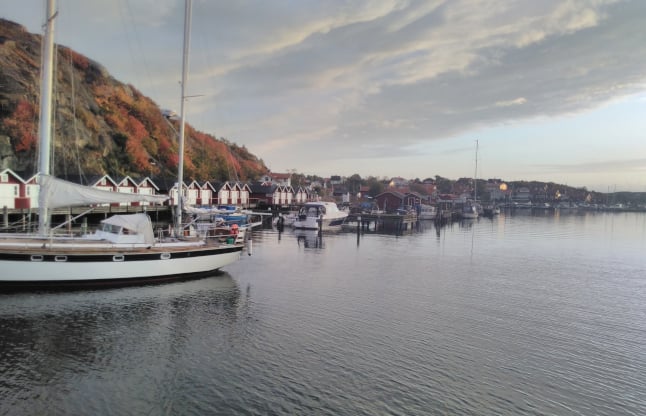Were the entire world to fall apart, at least there would be Brännö.
Or that has been my feeling, these last couple of corona-weeks. On March 17th I was supposed to take the train from my Swedish west coast home to Switzerland; a trip I take every two or so months, as my partner happens to live in a secluded, Wes Anderson-style hotel in the Swiss Alps, close to the Italian border.
From the Alps I would have travelled through Germany to the Netherlands, where I have my roots and where I was supposed to meet my friend's newest family member and celebrate another friend's 30th birthday party with a table filled with Indonesian food and wine and laughter.
From Amsterdam I would have taken my usual Flixbus to Copenhagen and the Øresund train back to Gothenburg, tram 11 to the harbour of Saltholmen and the Ylva or Fröja or one of the other ferries back home – back to the archipelago, to my island. Back to Brännö.
None of this happened, needless to say.
Between all my pretty plans and the present, the world all but stopped spinning. The Danish border closed one day before I was supposed to step on the train towards Copenhagen. For a moment there I thought I would be able to pull this off as long as I had proof that I wasn't interested in staying in Denmark and if I were to promise holding my breath while changing trains to Hamburg.
But then Germany closed its borders too, and Switzerland closed some of its cantons. The Wes Anderson-hotel had to close, as did all Swiss schools and ski resorts. Would I decide to take a flight despite all good intentions not to fly again? Before I had reached a decision on this moral dilemma all non-vital travel was strongly advised against. Traversing Europe to meet up with family or partners did not seem to be included in vital travel. The state had decided for me: I would stay put.
And while all lives Italian, Spanish, Norwegian, British, Dutch, Polish and German changed drastically and haltingly, my Swedish west coast life walked on calmly, without much ado.
Oh yes, there were visible changes when I commuted into town. The Ylva: nearly empty. The bus: as empty, the area around the driver cordoned off.
The streets in town were not nearly as empty as those seen on pictures of the Wuhan-province in China during lockdown. But still: quiet as if every day now was a Sunday and families were eating brunches in the safety of their homes. Which might as well be the case. My favorite Levantine cafe in town, close to Järntorget, was open but empty. The owners, two sisters, were struggling to stay afloat.
In front of the Östra Sjukhus, one of the city's main hospitals, staff had pitched an army field tent in case the hospital would overflow. It hadn't been in use thus far, but who knew what the near-future would have in store. No one had had a rehearsal, after all. There were no instruction guides; only estimated guesses and disasters witnessed from abroad.
Hagabadet, the original bathing house from the 1800s in the charming neighborhood of Haga, that has, for the last couple of decades, been functioning as a spa-cum-swimming pool-cum-fitness school, had moved several of its classes outside. The vulnerable can continue their workouts, but now use the cobbled streets of Haga as their gym, their own bodies as their weights.
A friend working at the Swedish Salvation Army tells me that they are keeping their doors open for the lonely in want of company. They too are seeing their numbers dwindle, not by lack of lonely people, but by lack of lonely people who venture out into this virus-silenced town.
Business owners struggle, waiters have no tables to wait on, shops scramble for toilet paper, trams run infrequently with half of all conductors falling ill.
Yet on Brännö life rolls on as the continuing ebb and flow I can see from my bedroom window.
The archipelago people appear largely unperturbed. There's around a thousand of us, on this rocky island. Sheep seem to outnumber the people. Brännö's pace of life is slow; the maximum speed is 20 km/h and cars are not allowed. So we walk, or we cycle.
The förskola stays open. Last Friday they were down 32 of 37 kids, one of the teachers tells me, but after a weekend of sunshine they're back to 16. They wash their hands and stay outside much of the time. But who would ever mind that? The spring decided to arrive in tandem with corona, after all.
The island shop, doubling as a post office – still open. A sign on the door asks those with symptoms to knock and stay outside. The lovely staff will personally shop for you; that is, if no other islander has already offered to do the job. Pinned to a board outside the shop are messages from the young and healthy, offering their free services to the somewhat less young or healthy.
And the sheep graze on, and the sun goes down, and I continue to go to the public sauna, politely staying 1.5 metres away from the other ladies' sweat.
The sun comes up again, and I thank it – it's not concerned about the virus. It remembers there was a before and there will be an after. And so the Brännö people seem to know.



 Please whitelist us to continue reading.
Please whitelist us to continue reading.
Member comments